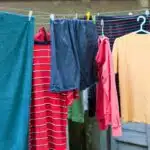As a textile care expert, it is important to understand the causes and prevention of pilling on clothes. Pilling is a common problem that occurs when fibers from the fabric loosen and tangle together, creating small balls or pills on the surface of clothing. While pilling is not a sign that your clothes are wearing out, it can be frustrating for individuals who want their clothing to look pristine.
There are several ways to prevent and remove pilling on clothes. One method is to choose clothing made from high-quality fabrics, such as wool or cashmere, which are less likely to pill than synthetic fabrics. Additionally, proper washing techniques can help prevent pilling by avoiding harsh detergents or over-washing clothes. In this article, we will explore various methods for preventing and removing pilling on clothes, allowing you to keep your wardrobe looking its best for longer.
Understanding The Causes Of Pilling
Have you ever experienced the frustration of seeing tiny balls of fabric surface on your clothes, making them look worn out and old? These pesky little balls are called pills, and they are a common problem with many fabrics. The causes of pilling can vary depending on the type of fabric and how often it is worn and washed. Understanding these causes can help prevent pilling and keep your clothes looking new for longer.
One cause of pilling is friction. When two surfaces rub together repeatedly, it causes the fibers to break or loosen, resulting in pills. This can happen during wearing, washing or drying clothes. Another cause is low-quality fibers. Poor quality fibers are more likely to break and pill over time than high-quality ones. Pilling may also be caused by harsh laundry detergents or fabric softeners that weaken the fibers.
To prevent pilling, there are several tips you can follow. Firstly, wash your clothes inside out to reduce friction between the fabric surface and other items in the wash load. Secondly, use a gentle cycle when washing your clothes as this will reduce the amount of friction between garments in the machine. Thirdly, avoid using harsh detergents or fabric softeners that can damage the fibers over time.
Different types of fabrics have varying tendencies towards pilling based on their fiber structure and quality. Understanding these tendencies will help you choose fabrics that are less prone to pilling and care for them properly to maintain their appearance over time.
Transitioning into the next section: Now that we have covered the causes of pilling and some prevention tips let’s take a closer look at different types of fabrics and their pilling tendencies.
Different Types Of Fabrics And Their Pilling Tendencies
Cotton is a delicate fabric that is prone to pilling due to its short fibers. Wool is also a delicate fabric that may pill, however with proper care it can be prevented. Synthetic fibers such as nylon and polyester are strong and less likely to pill. Silk is a strong fiber which tends to resist pilling with proper care. Linen is a strong fiber, however it is prone to wrinkling which can make it prone to pilling. Denim is a strong fiber that is highly resistant to pilling.
Cotton
Cotton is a widely used fabric in the textile industry. Organic cotton and Egyptian cotton are two popular types of cotton fabric that are known for their durability and softness. However, these fabrics also have tendencies to pill over time.
Organic cotton is grown without the use of harmful chemicals, making it an eco-friendly option for clothing production. Despite its benefits, organic cotton still has a tendency to pill due to its shorter fiber length. To prevent pilling on organic cotton clothes, it is recommended to wash them inside out and avoid using high heat when drying.
Egyptian cotton, on the other hand, has longer fibers than regular cotton, which makes it stronger and more resistant to pilling. However, even with its superior quality, Egyptian cotton clothes may still pill if not properly cared for. To prevent pilling on Egyptian cotton clothes, it is best to wash them in cold water and use a gentle cycle. It is also important to avoid using fabric softeners as they can weaken the fibers and cause pilling.
In conclusion, while organic cotton and Egyptian cotton are both great options for clothing production due to their durability and softness, they do have tendencies to pill over time. Proper care and maintenance can help prevent pilling on these fabrics so that they can be enjoyed for years to come.
Wool
Moving on to another type of fabric, wool is a popular choice for cold-weather clothing due to its insulating properties. However, it is also known for its tendency to pill over time. Proper wool care and sweater maintenance are crucial in preventing pilling on this fabric.
To prevent pilling on wool sweaters and other woolen garments, it is important to handle them with care during washing and drying. Machine-washing can cause friction between the fibers, leading to pilling. Therefore, it is recommended to hand wash wool clothes in cold water with a gentle detergent. For those who prefer machine-washing, using a delicate cycle with cold water temperature can help reduce the risk of pilling.
After washing, avoid wringing or twisting the garment as this can cause stretching and distortion of the fibers. Instead, gently press out excess water and lay flat on a towel to air dry. Avoid hanging wool garments as this can cause them to stretch out of shape.
In summary, proper wool care and sweater maintenance are essential in preventing pilling on this fabric. Whether through handwashing or machine-washing on delicate cycles with cold water temperature, handling your woolen garments with care will keep them looking new for longer periods of time.
Synthetics
Synthetics, as the name suggests, are fabrics that are made from synthetic fibers rather than natural ones. These fibers include polyester, nylon, and spandex, among others. Unlike natural fibers like wool or cotton, synthetics tend to be more durable and resistant to wear and tear. However, they also have a tendency to pill over time. To prevent pilling on synthetic clothes, it is important to handle them with care during washing and drying.
One of the main advantages of synthetic fabrics is their durability. They are able to withstand repeated use without losing their shape or structure. This makes them ideal for sportswear and other high-performance clothing items. However, this durability comes at a cost: synthetics tend to generate static electricity and attract lint and dust particles which can lead to pilling. To prevent this from happening, it is recommended to wash synthetic clothes inside out using cold water.
Eco-friendly alternatives such as bamboo fiber or recycled polyester have become more popular in recent years due to their low-impact production processes. These materials offer a viable alternative for those who want the benefits of synthetics without the environmental impact associated with traditional synthetic fabrics. As with all types of fabrics, proper care is essential in preventing pilling on these eco-friendly alternatives. By following these guidelines for washing and drying your clothes carefully, you can extend their lifespan and keep them looking new for longer periods of time.
The Importance Of Fabric Quality
Fabric quality is an essential factor to consider when purchasing garments that will last long without pilling. Fabric durability is the ability of a material to withstand wear and tear, washing, and other environmental factors without losing its original form or developing defects. Therefore, it is crucial to pay attention to the type of fabric used in making clothes.
Various pilling prevention techniques can be applied to maintain the quality of fabrics and prevent them from pilling. One such technique is selecting clothes made from high-quality fabrics such as silk, cotton, wool, or linen. These materials have natural properties that make them less prone to pilling. Additionally, avoiding synthetic fabrics such as polyester and nylon can reduce the risk of pilling.
When shopping for clothes, one should consider the garment’s thread count and weave since these factors determine how durable a fabric will be. Fabrics with a higher thread count tend to be more durable and less prone to pilling than those with lower thread counts. Similarly, tightly woven fabrics are less likely to pill than loose-woven materials. By paying attention to these aspects when selecting clothing items, one can ensure that they are investing in garments that will last longer without pilling.
Moving forward, it is crucial always to think about how to choose clothes that are less likely to pill since this contributes significantly to maintaining their quality over time. By considering factors like fabric type, thread count, and weave when selecting clothes and applying proper care techniques like gentle washing and avoiding harsh chemicals or rough handling during laundering, one can minimize the risk of pilling on their favorite clothing items.
How To Choose Clothes That Are Less Likely To Pill
When it comes to selecting clothes that are less likely to pill, it’s important to pay attention to the material. Natural fibers such as cotton, silk, and wool tend to pill less than synthetic fibers like polyester and nylon. However, high-quality synthetic blends can also be a good option. Look for materials with a tighter weave or knit as they are less likely to produce pilling.
Another factor to consider is the garment’s construction. Clothes that have been well-made with strong seams and stitching are less likely to pill compared to those with loose threads or poorly constructed sections. Additionally, avoid clothes that are too tight as friction from movement can increase pilling. Opt for looser-fitting clothing that allows for some breathing room.
There are also pilling prevention techniques you can use before wearing your clothes. One method is to gently wash new garments before wearing them as this eliminates any loose fibers on the surface of the fabric that could cause pilling. Another technique is using a fabric shaver or lint roller on your clothes regularly, removing any pills before they become more significant. By following these tips when choosing your clothing material and construction, you can reduce the likelihood of pilling and keep your garments looking their best for longer periods of time.
Transitioning into proper washing techniques to prevent pilling, it’s essential not only to choose the right materials but also take care of them properly. Excessive heat in the washing machine or dryer can cause fabrics to weaken and pill more easily over time. The subsequent section will cover how you can wash your clothes correctly while minimizing the risk of pilling so you can keep your wardrobe looking great for years to come.
Proper Washing Techniques To Prevent Pilling
To prevent pilling on your clothes, it is important to understand how fabric types react to different washing methods. For instance, fabrics like wool and cotton are more susceptible to pilling due to their natural fibers. Therefore, it is recommended to wash these fabrics with care by using a gentle cycle and mild detergent. On the other hand, synthetic materials such as polyester and nylon have a lower tendency to pill but can still occur if not washed properly.
Aside from selecting the appropriate cycle and detergent for your clothes, the drying method also plays an important role in preventing pilling. High heat from a dryer can cause friction between fibers which results in pilling. To avoid this issue, consider air-drying your clothes or using a low-heat setting on your dryer. Additionally, avoid overcrowding the dryer as this can lead to uneven drying and ultimately contribute to pilling.
By following proper washing techniques that cater to the specific needs of your fabric type and avoiding harsh detergents and fabric softeners, you can greatly reduce the occurrence of pilling on your clothes. It may require some extra effort and time, but it’s worth it in preserving the quality of your garments. In the next section, we will delve into why harsh detergents and fabric softeners should be avoided when washing clothes.
Avoiding Harsh Detergents And Fabric Softeners
Harsh detergents and fabric softeners are often used in the laundry process, but they can be detrimental to clothing fibers. These products contain chemicals that can weaken the fibers, making them more susceptible to pilling. As a textile care expert, I highly recommend avoiding these harsh chemicals altogether.
Thankfully, there are eco-friendly alternatives available that can help prevent pilling on clothes. Consider using natural fiber options such as cotton, linen, or wool, which are less likely to pill than synthetic materials. Additionally, try using eco-friendly detergents that don’t contain harsh chemicals or fabric softeners. These products are gentler on clothing fibers and won’t cause as much damage over time.
By avoiding harsh detergents and fabric softeners and opting for eco-friendly alternatives and natural fiber options, you’ll be able to prolong the life of your clothes and prevent pilling from occurring. But our journey towards preventing pilling doesn’t end here; we need to explore further the role of water temperature in pilling prevention. Let’s take a closer look at how adjusting the water temperature during washing can affect the likelihood of pilling on your clothes.
The Role Of Water Temperature In Pilling Prevention
Avoiding harsh detergents and fabric softeners is one way to prevent pilling on clothes. However, the importance of fabric composition cannot be overstated in this regard. Certain fabrics are more prone to pilling than others due to their structure and fiber type. For instance, natural fibers such as cotton, wool, and silk tend to pill more than synthetic ones like polyester or nylon.
Apart from the fabric type, the effect of fabric treatment on pilling prevention should also be considered. Fabric treatments like mercerization or singeing can improve a fabric’s resistance to pilling by removing loose fibers from its surface. Additionally, using a fabric shaver or lint roller can help remove pills that have already formed on clothes.
To further reduce pilling, it is recommended to air dry clothes instead of machine drying them. High temperatures and tumbling actions during machine drying can damage fabrics and cause them to pill more easily. Air drying also saves energy and extends the lifespan of clothes by reducing wear and tear caused by mechanical actions in washing machines and dryers.
Transition: While avoiding harsh detergents, considering fabric composition, and treating fabrics appropriately are crucial steps in preventing pilling on clothes, choosing the right method of drying can also make a significant difference in prolonging their lifespan.
Air Drying Vs. Machine Drying
- Air drying clothes is a traditional and gentle way to dry garments, and it is beneficial because it reduces the risk of shrinkage, fading and fabric damage.
- Machine drying is an efficient way to dry clothes and can be beneficial if the temperature settings are adjusted to the fabric type.
- Proper care of garments is the best way to prevent pilling, including using a mild detergent, avoiding overloading the washing machine, and using a low heat setting when tumble drying.
- Air drying clothes will reduce the mechanical friction between the clothes, which helps prevent the formation of pills.
- Machine drying can be beneficial in that it reduces the drying time of clothes; however, it can also increase the risk of pilling due to the added mechanical friction.
- To reduce the risk of pilling, clothes should be removed from the dryer promptly and gently stretched out upon removal.
Air Drying Benefits
Air drying is one of the most beneficial techniques for preventing and removing pilling on clothes. Benefits of air drying include reduced friction between clothing fibers, which can lead to less pilling overall. Additionally, air drying helps to minimize the heat damage that can occur during machine drying, which can contribute to weakening of fabric fibers and increase the likelihood of pilling.
To properly air dry your clothes, there are a few techniques that you should keep in mind. First, always shake out your clothing items before hanging them up to dry. This will help to ensure that any excess water is removed from the garment and prevent wrinkles from forming. Second, use hangers or a clothesline rather than folding your clothes over a rack or laying them flat on a surface. This will allow for proper airflow around the garment and prevent any rubbing or friction that could lead to pilling.
In conclusion, air drying offers many benefits when it comes to preventing and removing pilling on clothes. By following proper techniques such as shaking out clothing items before hanging them up and using hangers or a clothesline for drying, you can extend the lifespan of your garments and reduce the amount of pilling that occurs over time. Incorporating these practices into your textile care routine is an easy way to take care of your clothing investments while also reducing waste and promoting sustainability in fashion.
Machine Drying Benefits
When it comes to drying clothes, the debate between air drying and machine drying can often spark discussion. While air drying has its benefits in preventing and removing pilling on clothes, machine drying also offers a range of advantages that should not be overlooked. As a textile care expert, it is important to provide objective insights on both methods to enable individuals to make informed decisions based on their personal preferences and garment needs.
One of the primary benefits of machine drying is speed. Unlike air drying, which can take several hours or even days for certain fabrics to fully dry, a dryer can complete the process in a matter of minutes. Additionally, machine drying is convenient and less labor-intensive compared to hanging up clothes one by one or spreading them out flat. This means that individuals who are pressed for time may prefer using a dryer as part of their textile care routine.
Furthermore, some people find that fabric softeners used in conjunction with machine drying can help reduce pilling on clothing items. Fabric softeners work by creating a protective layer around the fibers which reduces friction during the tumbling process in the dryer. However, it should be noted that excessive use of fabric softeners or dryer sheets may cause buildup on clothing fabrics and lead to reduced absorbency over time. In summary, while air drying offers many benefits for garment care including pilling prevention and environmental sustainability, machine drying offers convenience and speed as well as potential pilling reduction through the use of fabric softeners.
Pilling Prevention
Fabric pilling is one of the most common issues faced by individuals when it comes to garment care. It affects the appearance and quality of clothing items, making them look worn out and old. Pilling occurs when fibers loosen from a fabric’s surface and tangle with each other during wear or washing. While both air drying and machine drying have their benefits, the method used can have an impact on pilling prevention.
When it comes to pilling prevention, choosing the right fabric types can make a significant difference. Natural fabrics such as cotton and wool are more prone to pilling compared to synthetic fabrics like polyester or nylon. However, fabric blends that include both natural and synthetic fibers can often offer the best of both worlds in terms of comfort, durability, and resistance to pilling. Additionally, using effective remedies such as fabric shavers or lint rollers can help remove any pills that do form on clothing items.
While air drying has been widely recognized as an effective way to prevent pilling on clothing items, machine drying can also play a role in reducing this issue. As previously mentioned, using fabric softeners or dryer sheets in conjunction with machine drying can help reduce friction between fibers which minimizes the likelihood of pills forming on clothing items during tumbling in the dryer. Ultimately, whether using air drying or machine drying for pilling prevention depends on individual preferences and garment needs.
Preventative Measures During Wear And Storage
To prevent pilling on clothes, it is important to take preventative measures during both wear and storage. Properly storing clothes can help prevent friction that leads to pilling. Clothes should be stored in a cool, dry place with plenty of space for air circulation. Avoid tightly packing clothes together, as this can cause rubbing that leads to pilling. Additionally, it is best to store clothes folded rather than hanging, as hangers can cause stretching and distortion of the fabric.
Using proper wearing techniques can also help prevent pilling. For example, avoid carrying heavy bags or wearing tight-fitting clothing over your garments, as this can cause friction and lead to pilling. Additionally, try not to sit in one position for too long, as this can create pressure points that rub against the fabric and cause pills to form. It is also important to follow care instructions on clothing labels, including washing at the appropriate temperature and avoiding harsh chemicals like bleach.
Finally, using a fabric shaver is an effective way to remove pills from clothing. This handy tool gently removes pills without damaging the fabric. Before using a fabric shaver, it is important to read the instructions carefully and test on an inconspicuous area first. To use a fabric shaver, simply run it over the surface of the garment in a circular motion until all pills are removed. Repeat as necessary until your garment looks like new again!
Using A Fabric Shaver To Remove Pills
Fabric shavers are an efficient and effective way to remove pills from clothes. This tool is particularly useful for removing pills from knitwear such as sweaters, blankets and scarves. The fabric shaver works by removing the top layer of the pills, which leaves the clothing looking fresh and new.
Fabric shaver benefits:
Easy to use: A fabric shaver is very easy to use, all you need to do is plug it in, turn it on and glide it over the affected area.
Saves time: With a fabric shaver, you can easily remove pills from your clothes without having to spend hours doing it manually.
Cost-effective: Investing in a fabric shaver will save you money in the long run as you won’t have to replace your clothes as frequently due to pilling.
Choosing the right fabric shaver:
When choosing a fabric shaver, there are a few things that you should consider. Firstly, look for one that has multiple settings so that you can adjust the level of abrasiveness according to the type of clothing you have. Secondly, choose one that is easy to handle and has an ergonomic design. Finally, make sure that it comes with additional accessories such as cleaning brushes or replacement blades.
In summary, using a fabric shaver is an excellent way to remove pills from your clothes quickly and efficiently. It’s important to choose the right fabric shaver for optimal performance and longevity. In the next section, we will discuss some manual methods for removing pills from clothing if you don’t have access to a fabric shaver or prefer not to use one.
Manual Methods For Removing Pills
As a textile care expert, I understand the frustration that comes with pills on clothes. Luckily, there are several manual methods for removing them. One of the simplest and most effective ways is to use a lint roller. This tool is specifically designed to remove lint and fuzz from clothing, making it perfect for removing pills as well. Simply roll the lint roller over the affected area until the pills are removed.
Another option for removing pills is to use Sweater stone alternatives. These stones are made from pumice and work by gently rubbing against the fabric to remove pills. To use them, simply rub the stone against the affected area in a circular motion until all of the pills have been removed. Just be sure to use caution when using these stones, as they can be abrasive and may damage delicate fabrics.
When it comes to manual methods for removing pills, it’s important to remember that prevention is key. Regularly washing your clothes according to their care instructions can help prevent pilling from occurring in the first place. Additionally, avoid using hot water or high heat settings when laundering your clothes, as this can cause fibers to break down and pill more easily. In our next section, we’ll discuss some common pilling mistakes to avoid so you can keep your clothes looking their best.
Avoiding Common Pilling Mistakes
As discussed in the previous section, manually removing pills from clothing can be a tedious task. However, it is essential to understand that prevention is always better than cure. Did you know that pilling occurs in up to 80% of fabrics? This statistic highlights the need for effective pilling prevention techniques.
Common pilling mistakes are often made unknowingly, leading to an increase in pilling. One of the most common mistakes is washing clothes too frequently or using harsh detergents. This can cause friction between fibers and lead to breaks, resulting in more pills. Another mistake is exposing clothes to high heat during drying or ironing, which damages fibers and leads to increased pilling.
Effective pilling prevention techniques include:
- Choosing high-quality fabrics with longer fibers
- Washing clothes less frequently and on gentle cycles
- Using mild detergents specifically designed for delicate fabrics
- Avoiding exposure to high heat
By implementing these simple techniques, you can avoid common pilling mistakes and keep your clothes looking new for longer. However, if your clothes have already started to pill extensively, it may be time to consider replacing them with newer ones. In the next section, we’ll discuss when it’s time to say goodbye to clothing that has already pilled beyond repair.
When To Replace Clothing That Has Pilled
Clothing is an essential part of our daily lives, and it goes through a lot of wear and tear. Pilling is a natural occurrence in many fabrics, including cotton, wool, and synthetic blends. It happens when short or broken fibers tangle together to form little balls on the surface of the fabric. Over time, these pills can become unsightly and make your clothes look worn out.
Replacing pilled clothing depends on several factors. Firstly, the extent of pilling determines whether you should replace the garment or not. If it’s minor pilling that doesn’t affect the overall appearance of the clothing, you can still wear it for some time. However, if there are large balls of pills that make the garment appear old and damaged, it’s time to replace it.
Secondly, consider the age and quality of the clothing. If you’ve had a garment for years and have worn it frequently, it may be time to replace it regardless of whether or not there is pilling. Similarly, low-quality garments tend to pill more quickly than higher-quality ones; hence they need replacing sooner.
In conclusion, knowing when to replace pilled clothing is crucial in maintaining a neat wardrobe. Factors such as extent of pilling and quality/age play significant roles in determining whether a piece needs replacement or not. However, preventing pilling altogether is even better than having to deal with its consequences later on. In the next section, we will explore how you can prevent pilling on specific garments such as sweaters or leggings.
Preventing Pilling On Specific Garments, Such As Sweaters Or Leggings
When attempting to prevent pilling on garments such as sweaters and leggings, washing methods, fabric choice, detergents, and dryer settings must be taken into consideration. Additionally, ironing, proper storage, seam treatment, napping techniques, layering, avoiding abrasion, quality checks, care labels, trimming loose threads, wearing habits, and fabric softeners should all be considered. These factors can help to prevent pilling and maintain the quality of the garment. To ensure the garment will last, following proper care instructions is essential.
Washing Methods
As a textile care expert, preventing pilling on specific garments such as sweaters or leggings involves proper washing methods. Pilling occurs when fibers from the fabric rub together during washing and cause small balls of fabric to form on the surface. To prevent this, it is important to use eco-friendly detergents that are gentle on the fabric.
Hand washing techniques are highly recommended for delicate fabrics such as wool or cashmere. When hand-washing, fill a sink with lukewarm water and add a small amount of detergent. Submerge the garment in the water and gently agitate it, avoiding any twisting or wringing motions which can cause pilling. Rinse thoroughly, then press out excess water by rolling the garment in a towel before laying it flat to air dry.
If machine-washing is necessary, be sure to turn the garment inside out before placing it in the washer. Use a gentle cycle with cold water and avoid overloading the machine which can cause excessive rubbing between garments leading to pilling. Always read care labels for specific washing instructions and try to avoid using fabric softeners which can also contribute to pilling. By following these washing methods, you can ensure your garments remain pill-free and last longer.
Fabric Choice
When it comes to preventing pilling on specific garments such as sweaters or leggings, fabric choice plays a crucial role. The durability of the fabric and its fiber content are important factors to consider when selecting a garment. Fabrics that have a higher percentage of synthetic fibers such as polyester, nylon or spandex tend to be more durable and less prone to pilling than natural fibers like wool or cashmere.
However, natural fibers offer certain benefits that synthetic fibers cannot match such as breathability and softness. If you prefer natural fibers, it is best to opt for high-quality fabrics that have been knitted tightly to reduce the likelihood of pilling. Additionally, blends of natural and synthetic fibers can offer the best of both worlds by combining the durability of synthetics with the comfort of natural fibers.
It is also important to consider how you will wear and care for your garment when choosing a fabric. Garments that will undergo frequent rubbing against other surfaces like backpacks or car seats may benefit from more durable fabrics, while garments that will only be worn occasionally may prioritize comfort over durability. By taking these factors into account when selecting fabrics for your wardrobe, you can reduce the likelihood of pilling and ensure your garments last longer.
Frequently Asked Questions About Pilling Prevention And Removal
As a textile care expert, it is important to address the most common concerns about pilling prevention and removal. Pilling causes vary from garment to garment, but some of the main culprits include low-quality fabric, friction from regular wear, and improper washing and drying techniques. To prevent pilling, it is best to invest in high-quality garments made from natural fibers like wool or cotton. These fabrics are less prone to pilling and will last longer with proper care.
Prevention measures don’t end with purchasing high-quality garments, as proper washing and drying techniques are equally important. When washing clothes, avoid using harsh detergents or fabric softeners as they can weaken the fibers in the fabric. Opt for gentle detergents specifically designed for delicate fabrics like wool or silk. Additionally, air-drying your clothes instead of using a dryer can help prevent pilling caused by friction from the tumbling action.
While prevention is key, sometimes pilling is inevitable. If you notice pills on your clothing, there are several ways to remove them safely. One option is to use a fabric shaver or lint roller to gently remove the pills without damaging the fabric. Another method involves using a razor blade or scissors to carefully cut away the pills. However, it’s important to exercise caution when using sharp objects near delicate fabrics as they can easily be damaged if not handled properly.
Overall, preventing and removing pilling on clothes requires careful attention to detail and proper care techniques. By investing in high-quality garments made from natural fibers and following recommended washing and drying methods, you can prolong the life of your clothing and keep them looking their best for years to come.
Conclusion
In conclusion, preventing and removing pilling on clothes requires a comprehensive understanding of the causes of pilling, the different types of fabrics and their tendencies, and the importance of fabric quality. It is also crucial to choose clothes that are less likely to pill and use proper washing techniques to prevent pilling. Avoiding common mistakes when washing and drying clothes can go a long way in preventing pilling.
It is important to remember that even high-quality clothing will eventually pill, but knowing when it is time to replace your garment can help prolong its lifespan. By following these tips for preventing and removing pilling, you can ensure that your clothes look great for longer periods, saving you money in the long run. As a textile care expert, I recommend taking these preventive measures seriously to avoid unwanted pilling on your favorite garments. Remember, prevention is always better than cure!
Image Credits











![How To Wash And Care For White Clothes 11 The only genuine borax soap cleanses hygienically saves the clothes and hands. 20 Mule-Team brand Boraxo white laundry soap [front]](https://green-life.blog/wp-content/uploads/2023/05/YDXLLCovnOjq-150x150.jpg.webp)

















